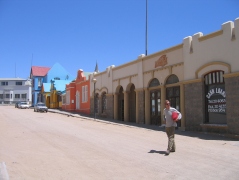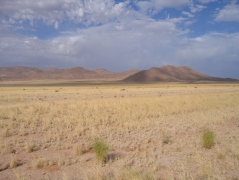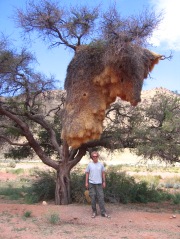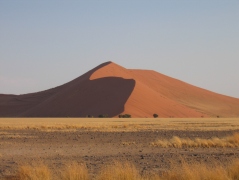After leaving Cape Town in January we sailed north, wanting to explore the coast of Namibia before heading for the remote island of St Helena far out in the South Atlantic. Our first port of call was the small town of Lüderitz, where every afternoon without fail the wind would blast through the anchorage in savage 40 knot gusts. Although the shore was only a short distance from Stella Maris, to cover it without being blown backwards was a challenge that required good timing and a concerted burst of hard rowing.
Nestled between the desert and the ocean, Lüderitz’s colonial architecture and quiet sand-covered streets gave it the air of a town that time forgot. Originally a trading post built up around whaling, seal-hunting and fishing, it became prosperous at the start of the twentieth century when diamonds were discovered in the area. The boom was relatively short-lived and came to an end in the 1920s when mining activity shifted to towns further south. We got a fascinating glimpse of the area’s diamond mining heyday in the nearby ghost town of Kolmanskop, where dilapidated German-style houses were filled with piles of shifting sand blown in from the Namib Desert.
When local tour boat operator Günther kindly let us use his mooring, we dared to leave Stella Maris for a few days to explore inland. Recent rain had left the desert covered in yellowy green grass that rested like a layer of soft velvet on the sandy plains, the jagged hills rising up magically in the distance. We saw wild horses and oryx by the roadside, the amazing straw skyscraper nests constructed by hundreds of weaver birds, beautiful quiver trees, and the magnificent sand dunes of the Sossusvlei, burned ochre by the setting sun.
Leaving Lüderitz we continued north, pulling in at uninhabited Hottentot Bay after a day of light wind. A captain from one of the dozen fishing boats already there called us on the VHF to say it was safe to anchor deep in the bay, and warned us not to go onshore as it was part of the vast Sperrgebiet, a Prohibited Area due to diamond mining. The fishermen proved more welcoming than the miners, rowing over in a dory to give us a bag of crayfish.
The arrival of north winds and fog confined us to the bay for a day, but when all the fishing boats departed the next morning the anchorage became so eerie that, despite fog and a lack of wind, we left too. The dead calm water made it easy to spot seals, and an African penguin even appeared right beside the boat. Dolphins and seabirds came from all directions to send us on our way, and a tern hitched a ride for a while, paying for his passage with unwanted guano. By late afternoon the fog finally lifted and the sun lit up our world, but the dark night brought a cold front and sustained 30 knot winds that made us very glad we’d left Hottentot Bay.
When we rounded the cardinal at the entrance to Walvis Bay, Namibia’s largest commercial port and our final destination on the African continent, we had a long and wet ride against the wind to reach the anchorage in front of the Yacht Club. With rusting fishing boats at anchor and industrial cranes rising up from the dockyard it wasn’t the most picturesque of spots, but Walvis Bay had pleasant surprises in store for us.
In the Yacht Club we met Etienne, a local who kindly offered to take us on a trip through the desert to see the beautiful red sand dunes and the pretty neighbouring town of Swakopmund. And when we took our dinghy to explore the long, sandy peninsula of Pelican point, we not only discovered its large and pungent colony of Cape fur seals, but also professional sailors Paul Larsen and Helena Darvelid, and their aptly named speed machine, the Sailrocket.
With its narrow 9 metre-long hull, 8.3 metre crossbeam and towering wing sail, the Sailrocket looked like something from the future, but it was designed to break the present-day world sailing speed record. Paul and Helena had relocated it from the busy waters of Portland Harbour in the UK to Namibia because Walvis Bay offered the ideal conditions for their quest: reliable strong winds, flat water, and an absence of other boats to crash into when it reached full throttle.
On that day in March 2007 we had the privilege of witnessing Paul attempt to break the 50 knot barrier. We watched from the beach as the Sailrocket accelerated across the water, but saw disaster strike when the boat became unstable and flipped spectacularly upside down. Thankfully Paul emerged unscathed, but the team were deflated to discover that the wing-sail had suffered significant damaged. By the time the boat was back onshore, though, their spirits were already lifting and they started to plan the necessary repairs.
As we sailed away from Namibia and continued to follow our own dream, the Sailrocket team stayed on to pursue theirs. It was an endeavour that would stretch into the next five years as they found sponsorship, redesigned the boat, built Sailrocket 2, and continued to push for the record. And on November 24th 2012 Paul not only broke the 50 knot barrier but smashed the world record, reaching an average speed of 65.45 knots over 500 metres. A dream ten years in the making had finally come true, and Paul became the fastest sailor on the planet.








